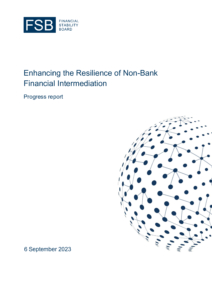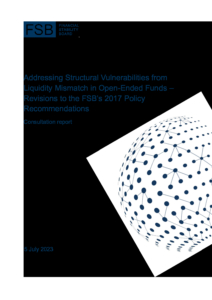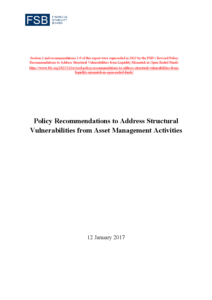Summary of document history
A key structural vulnerability from asset management activities is the potential mismatch between the liquidity of fund investments and daily redemption of fund units in open-ended funds.
In 2017, The 2017 FSB Recommendations aimed to:
-
strengthen regulatory reporting and public disclosure to facilitate assessment of liquidity risk in OEFs;
-
promote liquidity management both in the fund design phase and on an ongoing basis;
-
widen the availability of LMTs and use of LMTs in stressed market conditions; and
-
promote fund-level and system-wide stress testing.
IOSCO operationalised most of the FSB Recommendations through its Recommendations for Liquidity Risk Management for Collective Investment Schemes in 2018 and a set of related good practices.
In 2022, as part of its work programme to enhance the resilience of non-bank financial intermediation, the FSB assessed the effectiveness of the FSB Recommendations. Based on the findings of the assessment report, the FSB and IOSCO agreed to carry out follow-up analytical and policy work. On 5 July 2023, the FSB published a consultation report in response to some of the findings of the assessment report.
This final report incorporates feedback from the public consultation. It sets out the Revised Policy Recommendations to Address Structural Vulnerabilities from Asset Management Activities in relation to liquidity mismatch in open-ended funds (OEFs). The revised recommendations supersede Section 2 of the FSB’s 2017 Policy Recommendations to Address Structural Vulnerabilities from Asset Management Activities. The revised recommendations form part of the FSB’s work programme on non-bank financial intermediation (NBFI) and should be read in conjunction with the IOSCO Guidance on Anti-Dilution Liquidity Management Tools (LMTs) [link].
The goal of the revised FSB Recommendations, combined with the new IOSCO guidance on anti-dilution LMTs, is a significant strengthening of liquidity management by OEF managers compared to current practices.
Revised FSB policy recommendations
Recommendation 1: Authorities should collect information on the liquidity profile of open-ended funds in their jurisdiction proportionate to the risks they may pose from a financial stability perspective. They should review existing reporting requirements and enhance them as appropriate to ensure that they are adequate, and that required reporting is sufficiently granular and frequent.
Recommendation 2: Authorities should review existing investor disclosure requirements and determine the degree to which additional disclosures should be provided by open-ended funds to investors regarding fund liquidity risk and the availability and use of liquidity management tools, proportionate to the liquidity risks funds may pose from a financial stability perspective. Authorities should enhance existing investor disclosure requirements as appropriate to ensure that the required disclosures are of sufficient quality and frequency. In this regard, IOSCO should review its 2018 recommendations and, as appropriate, enhance them.
Recommendation 3: In order to reduce material structural liquidity mismatches in open-ended funds, authorities should have requirements or guidance on funds’ liquidity risk management. Such requirements or guidance should state that funds’ investment strategies and the liquidity of their assets should be consistent with the terms and conditions governing fund unit redemptions both at the time of designing a fund and on an ongoing basis. The redemption terms that open-ended funds offer to investors should be based on the liquidity of their asset holdings in normal and stressed market conditions. In this regard, IOSCO should review its 2018 recommendations and, as appropriate, enhance them.
Recommendation 4: Authorities should ensure that a broad set of liquidity management tools and measures is available for use by managers of open-ended funds in normal and stressed market conditions as part of robust liquidity management practices. Authorities should also reduce operational and other barriers that prevent the use of such tools and measures. In this regard, IOSCO should review its 2018 recommendations and, as appropriate, enhance them.
Recommendation 5: Authorities should ensure that anti-dilution liquidity management tools are available to managers of open-ended funds. Authorities should also ensure that managers of open-ended funds consider and use such tools to mitigate potential first-mover advantage arising from structural liquidity mismatch in open-ended funds they manage, to ensure that investors bear the costs of liquidity associated with fund redemptions, and to arrive at a more consistent approach to the use of liquidity management tools. Such tools should impose on redeeming investors the explicit and implicit costs of redemptions, including any significant market impact of asset sales to meet those redemptions. In this regard, IOSCO should review its 2018 recommendations and, as appropriate, enhance them as well as to prepare guidance on the design of anti-dilution liquidity management tools.
Recommendation 6: Authorities should require and/or provide guidance on stress testing at the level of individual open-ended funds to support liquidity risk management to mitigate financial stability risk. The requirements and/or guidance should address the need for stress testing and how it could be done.
Recommendation 7: Authorities should promote (through regulatory requirements or guidance) clear decision-making processes for open-ended funds’ use of quantity-based liquidity management tools and other liquidity management measures, particularly in stressed market conditions. The processes should be made transparent to investors and the relevant authorities. In this regard, IOSCO should review its 2018 recommendations and, as appropriate, enhance them.
Recommendation 8: While asset managers have the primary responsibility to consider and use quantity-based liquidity management tools and other liquidity management measures, authorities should provide guidance on their use particularly in stressed market conditions. In this regard, IOSCO should review its 2018 recommendations and, as appropriate, enhance them. Where jurisdictions consider it appropriate, authorities should also provide direction in stressed market conditions regarding open-ended funds’ use of such tools and measures, taking into account the costs and benefits of such action from a financial stability perspective.
Recommendation 9: Where relevant, authorities should give consideration to system-wide stress testing that could potentially capture effects of collective selling by funds and other investors on the resilience of financial markets and the financial system more generally.


